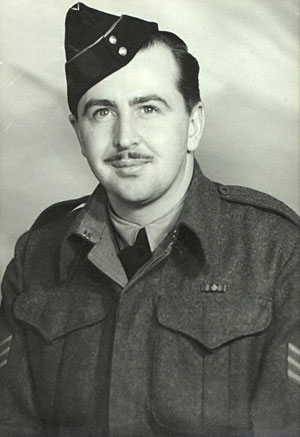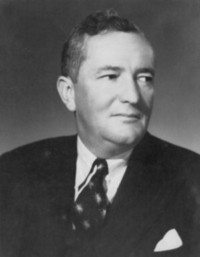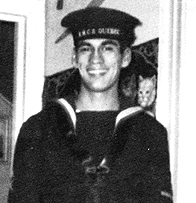Canada Remembers Times - 2012 Edition - Page 3
Super Spies
In wartime, getting information on the enemy’s plans is very important but challenging. This is where spies come in. Often secretly working behind enemy lines, it is very dangerous work. If captured, they can expect harsh interrogation and even execution. Many brave Canadian spies, like the ones mentioned below, risked their lives to help the Allies achieve victory.
The Spy from PEI

Clifton Stewart during the war.
Photo courtesy of Stewart Family.
Clifton Stewart was born in P.E.I. He had a knack for electronics and, by the age of 19, he was a budding amateur radio genius. One day, two RCMP officers went to the family farm and informed Stewart that the British secret service wanted to recruit him. They somehow knew that he was an electronics whiz.
Young Mr. Stewart was sent to the British Security Coordination Office in New York City, to work on the “Rockex” project with a handpicked team. The machine they developed was used to encipher almost all secret telegrams between London and New York during the Second World War.
Going by the code name W5 (because he was the fifth spy recruited from the Western Hemisphere), he moved on to Camp X in Whitby, Ontario. There he honed his craft with other coding and demolition experts. Stewart was then sent on top secret missions in occupied Europe. Dropped behind enemy lines, a team of agents would set up radio communications with “the spy from P.E.I.” hauling a briefcase containing a coding machine. Information was gathered and messages sent. Mission accomplished, the team would fly back to safety.
What exactly were these missions? Well that is still not entirely known. . . . Stewart died in P.E.I., with his secrets, at age 91.
Special Agent Guy Biéler

Book about Biéler written by his daughter.
Image courtesy of Norm Christie/
www.cefbooks.ca
Gustave “Guy” Biéler was born in France in 1904 and moved to Montréal at the age of 20. When the Second World War broke out, he joined Le Régiment de Maisonneuve. His French background and perfect English led him to be recruited by the “Special Operations Executive” in London for espionage training.
Although badly injured while parachuting into occupied France in November 1942, he organized and led the French Resistance’s “Musician” network. Based in Saint-Quentin, the network attacked fuel depots, factories and transportation targets in a large area of northern France. Its sabotage efforts were so effective that the Germans formed a special team to eliminate it. The Gestapo finally arrested Biéler in January 1944. Despite the extensive torture and starvation he suffered at the Flossenbürg concentration camp, he revealed nothing to his interrogators. The Germans executed Biéler in September 1944.
Biéler was posthumously awarded the Distinguished Service Order and made a Member of the Order of the British Empire. Today, a street in Saint-Quentin and a memorial in Montréal bear his name.
A Man Called Intrepid

Sir William Stephenson.
Photo: The Intrepid Society
Manitoba’s William Stephenson was a pilot in the First World War who earned several medals for bravery. His plane was shot down; he was wounded and then captured by the Germans, but managed to escape. He would return to service in the Second World War in a very different role.
Stephenson became chief of the British Security Coordination (BSC) and the brain behind “Camp X.” It was a secret training facility for Allied spies, established near Whitby, Ontario, in late 1941. It featured “Hydra,” a sophisticated communications encoding centre. Very few people were aware of the true purpose of Camp X, including Canadian Prime Minister Mackenzie King.
Allied agents were trained there in silent killing, sabotage, demolition, map reading, weapons and Morse code. Once ready, the agents were dropped behind enemy lines to do their work.
Ian Fleming, later famous for writing the James Bond novels, trained at the camp. His Bond character was supposedly based on Stephenson and what Fleming learned from him. Colonel William “Wild Bill” Donovan, wartime head of the U.S. Office of Strategic Services, credited Stephenson with teaching Americans about foreign intelligence gathering.
The camp was later abandoned, its buildings demolished or relocated, and its records destroyed or locked away under the Official Secrets Act. Today, the former site of Camp X is known as “Intrepid Park,” named after Stephenson’s wartime code name. A monument honours the men and women who trained and worked there.
Did You Know?
Canada was far away from most of the fighting during the Second World War, but we were not safe from enemy attack. In late 1944 and early 1945, the Japanese released thousands of large bomb-carrying balloons that high-altitude winds blew across the Pacific Ocean.
Hundreds of these explosive devices reached North America and some landed in British Columbia, Alberta, Saskatchewan, Manitoba, the Yukon and the Northwest Territories. The Japanese hoped the bombs would start forest fires and spread panic, but very little damage resulted.
A Family Tradition at Sea

Ronald Lowry in 1955.
Photo: VAC
Ronald Lowry, originally from the Bay of Quinte Mohawk Band in Ontario, was 17 when he applied to join the Royal Canadian Navy in 1949. The Korean War erupted in 1950 and Lowry soon found himself aboard HMCS Nootka on the other side of the world.
A sonar operator, he kept watch for enemy submarines and torpedoes off the Korean coast. Lowry had also been trained in demolition work. He used these skills when he worked with South Korean and British marines in commando raids to destroy enemy bridges, railways and other strategic installations.
Following the war, Lowry served aboard mine sweepers, cruisers and patrol vessels before retiring after almost ten years in uniform. Coming from a family with a strong history of military service, the tradition continued with Lowry marrying a Wren (a member of the Women’s Royal Canadian Naval Service) and four of his five sons also serving in the Navy.
Did You Know?
In 1918, during the First World War, a German U-boat (submarine) captured a Canadian trawler off the Nova Scotia coast. The Germans put a small crew aboard the trawler with weapons and a radio, and then set off on a three-day cruise of destruction. The ship was well-known to the fishing fleet and could get within rifle range before anyone noticed its German flag. Seven schooners were captured and sunk before the trawler ran out of coal. The Germans then scuttled it, ending its short career as an enemy warship.
- Date modified: